Welcome back to the Famous Studio Archive. Before we move on to 1946-47 season, a few more items from the 1945/46 era to observe. For example, this…
The Noveltoon Jack-In-The-Box Opening

This iconic signature open for the Paramount Noveltoons made its debut in 1943 and was used for about twelve years. It was an attempt to brand the miscellaneous one-shots and to link the cartoons as a series. However, several times during the 1940s, this generic Jack logo wasn’t used. For some of Noveltoons (for example, The Friendly Ghost, The Enchanted Square, The Wee Men) the studio was aiming for some kind of prestige by not using the common opening.
Steve Stanchfield shared this information about the man who actually animated the Jack-In-The-Box opening, Gordon Sheehan:
Sheehan said he animated the sequence to me and many others- I asked him about it in 1988 or so. He said it was one of the first assignments at the ‘new’ studio… so it’s less of a speculation than a remembrance. He was upset that the prints that he had in 16mm were missing the logo and thought it was a nice way opening for these cartoons.
Sheehan wasn’t a person to misremember things- if he knew, he knew- if not, he would state so immediately. The inbetween notes are very similar in writing to his writing as well in later years, so this seems to confirm it. So, I would say it’s certain (he did it). He was one of the last animators that continued to work in New York for a while (after the Fleischer’s moved to Miami), and said a lot of (the Popeye two-reeler) “Aladdin And His Wonderful Lamp” was produced there, and that David Tendler’s unit was producing some cartoons there as well as finishing his duties on the two-reel color short.
Sheehan was very clear to state he animated the *original* Jack in the Box, and designed the character. He said that the scene was drawn large to allow for a ‘truck’… and of course seeing the drawings confirmed that. He also said the name ‘Noveltoon’ started out as something like ‘An Animated Novelty’. Paramount asked them to do a series to test various properties that they considered licensing for the studio. He said that the war caused Paramount to cut as many expenses as possible, so some of those were never produced, or produced after the war (the “Snuffy Smith” (Spree For All) is the only one that comes to mind as being possibly part of that).
Click to enlarge some of the surviving animation art from this opening, below:
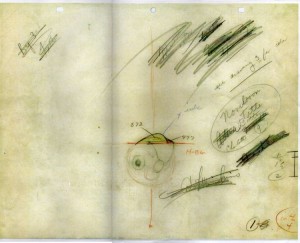





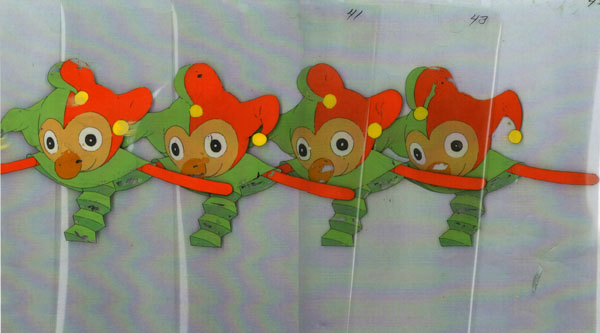

Of course the Noveltoons Jack morphed into the Harveytoons Jack (or “Ha-Ha” as they began calling him in the 1990s) and the even more iconic Harvey Comics logo. More about this in a future Famous Studios post.
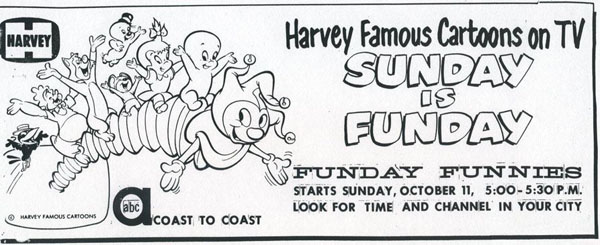
Sales Department
The clippings below are from several motion picture trade magazines circa late 1945, and they show the hand-writing on the wall. (click each page below to enlarge and read) It’s hard to believe some of the statistics cited, especially in comparison with each other. The first poll, for BoxOffice Magazine, lists George Pal’s Puppetoons as #5 in their top ten shorts series. There is no denying that Pal’s Puppetoons were at the height of their popularity at this point – but it is the only Paramount series to make the cut.
The second poll (I believe this page, by Mandel Herbstman, is from Motion Picture Herald) lists the top 25 “money makers” among shorts series, and here Paramount’s partially animated Speaking of Animals ranks #6! Famous’ Popeye is #8 and Little Lulu ranks #11. The Puppetoons are #19 (and note Screen Gems’ Fox & Crow at #23).
The third (a 3-page article) reports the results of Showmen Trade Reviews “Leaders of the Motion Picture Industry” poll. Similar to the BoxOffice magazine results, Paramount’s greatest hope here is not from their in-house Famous Studios but from Pal’s puppet factory. Regardless, Popeye was still a strong feature for the studio. Though the fate of Little Lulu may have been determined.

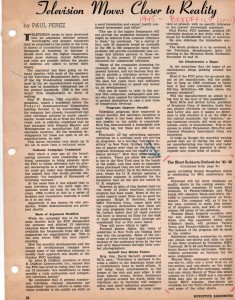

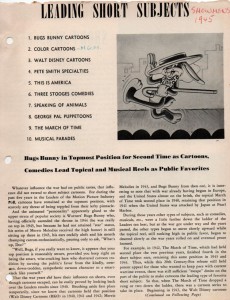



This image – from an issue of Boxoffice – was also used on a postcard sent to theatre managers in August 1945.
Comics Department
And finally this week, let’s acknowledge the studio’s licensing deal with Western Publishing (Dell Comics). Famous didn’t last long at Western – only two years (1944-45) – with their characters used as back-up features (to Pogo) in Animal Comics. You can feel the editors desperately fishing for a “star” personality among the Noveltoon wannabes: Blackie Sheep, Cilly Goose, Hector The Henpecked Rooster and his sidekick, Herman the Mouse. On the plus side, the stories were crafted by such notables as John Stanley, animators Tom Golden, Otto Feuer, Rube Grossman and most significantly, Walt Kelly.
Here is the final Hector and Herman story, from the last issue they appeared in, Animal Comics #17 (November 1945) drawn by Walt Kelly. (click pages below to enlarge)
(Thanks this week go to Frank M. Young, Steve Stanchfield, Bob Jaques, Don Yowp and Mark Kausler)




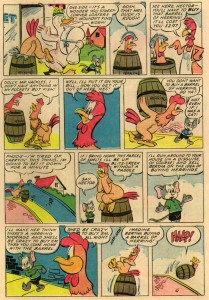

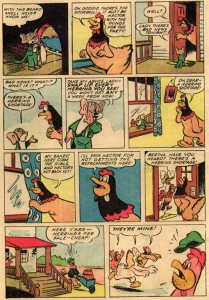
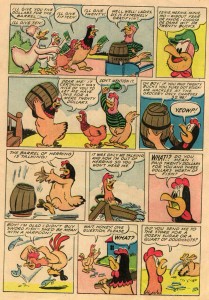
 Jerry Beck is a writer, animation producer, college professor and author of more than 15 books on animation history. He is a former studio exec with Nickelodeon Movies and Disney, and has written for The Hollywood Reporter and Variety. He has curated cartoons for DVD and Blu-ray compilations and has lent his expertise to dozens of bonus documentaries and audio commentaries on such. Beck is currently on the faculty of CalArts in Valencia, UCLA in Westwood and Woodbury University in Burbank – teaching animation history. More about Jerry Beck [
Jerry Beck is a writer, animation producer, college professor and author of more than 15 books on animation history. He is a former studio exec with Nickelodeon Movies and Disney, and has written for The Hollywood Reporter and Variety. He has curated cartoons for DVD and Blu-ray compilations and has lent his expertise to dozens of bonus documentaries and audio commentaries on such. Beck is currently on the faculty of CalArts in Valencia, UCLA in Westwood and Woodbury University in Burbank – teaching animation history. More about Jerry Beck [



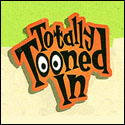



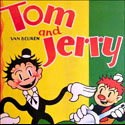
The Showmen Trade Reviews list is the most interesting since that one seems to rank based on box office success in the year. The other two lists are more of “B.O. favorites lists” involving otherwise unknown factors. Or maybe I just like it best because it states that cartoons were the box office kings of short subjects.
Interesting to see that The Three Stooges maintained top appeal for several years (according to the last article) and except for Pete Smith, had been #1 money-maker for the theaters in the genre of live-action comedy shorts.
What’s most surprising is how popular the Speaking of Animals series was. Who knew it was that popular?
As far as the comics were concerned, the only original Famous studios character that had lasting success seems to have been Casper. Out of curiosity, when did Casper comics first start?
Yeah… I love the ol’ listings of “top selling shorts”. Even posted some blogs about it in the TCM fan forum.
http://fan.tcm.com/blogpost/a-couple-of-ol-movie-lists-of-interest-what-about-the-shorties-part-1
http://fan.tcm.com/blogpost/a-couple-of-ol-movie-lists-of-interest-what-about-the-shorties-part-2
http://fan.tcm.com/blogpost/a-couple-of-ol-movie-lists-of-interest-what-about-the-shorties-part-3
I wish the BoxOffice.com site made their archive more accessible these days as it did in the past. I loved all of the November “special” issues focused on the “season of shorts” both animated and live-action. That was a wonderful era (ending when Universal and United Artists were the last majors to pull the plug on shorts in the 1970s). Today we just get trailers and car commercials in movie theaters
The first issue of Casper, The Friendly Ghost, by St. John Publishing, appeared with a September, 1949, cover date, so it probably hit the newsstands in June or July of that year.
The older BoxOffice issues that were available through the “Vault” section of their website still are; the main “Vault” page just doesn’t link to them anymore. Copy the following URL into your browser and add the desired year at the end:
http://pro.boxoffice.com/the_vault/issues_by_year?year=
Wow! If you hadn’t identified this Hector the Henpecked Rooster story as having been drawn by Walt Kelly, I’d’ve never known it. Now that you mention it, you can see the Kelly style in some scenes; the rampaging earth mover, for example.
I used to live in Culver City, CA, in one of a row of low-rent apartment houses, many of which had tenants from Latin America for a few months. Many of them kept poultry, which was illegal (live roosters and chickens in residential apartments) but seldom enforced. The roosters and chickens were always getting loose and walking up & down the sidewalk, often into my apartment house’s yard. I was amused by how the rooster would strut into the yard, carefully inspect it, and crow to the hens that it was safe for them to enter. The hens had ignored him and already entered the yard and were scratching for food by that point. The roosters didn’t crow just at dawn; they crowed 24/7 about everything — yes; always at the sun’s rising. And about any dogs or cats in the neighborhood.
You don’t have to remind me of that (having had a backyard full of chickens as a kid in a suburban neighborhood).
Money talks, so I’d guess the ‘money maker’ poll was likely the most accurate of the three listed above, in gauging how the theater owners, and in turn the studios, felt about their cartoon series. That might have made things a little better for Famous than the other two polls did, but Lulu’s spot outside the Top 10 probably does show why Paramount wasn’t going to renew the licensing agreement if the price was too high.
The advent of widescreen, and the desire by studios to format their non-CinemaScope cartoons to be seen in both that form and in the standard Academy ratio, may have helped doom the original Noveltoons opening, since the truck out relied on an wider vertical ratio. By 1954-55, Paramount had ‘tightened up’ the opening credits on their cartoons to work in widescreen form, but the jack-in-the-box opening had to reduced in size and even then, the Paramount logo had to be cropped at the bottom of the picture during the truck out to accommodate the more rectangular screen size, if the cartoon was playing in widescreen.
The result was the revised and pretty boring opening for the Noveltoons from 1955 onward. But since the aspect ratio for television until a decade ago was similar to the original theatrical aspect ratio, the modified jack-in-the-box titles worked fine for the Harveytoons package.
According to the Grand Comics Database, the first issue of “Casper the Friendly Ghost” comics was dated September 1949, from the St. John Publishing Company. St. John published 5 issues between 1949-51 and then Harvey took over the character.
Funday Funnies later Matty’s Funday Funnies was sponsored by Mattel Toys using thier mascot Matty as “host” of the series. I remembered the toy Casper the Friendly Ghost Jack in the Box that Mattel sold (surprised that they Mattel didn’t had a toy Jack in the Box version of the Harvey mascot for sale!) later when Bob Calmpett’s Beany and Cecil took over the spot that was held by the Casper and his Harveytoon crew, Harvey/Paramount created The New Casper Show featuring Casper, Spooky,Wendy and company in brand new adventures and featuring Modern Madcaps episodes from the 1950 ‘s (including my favorite Boppin’ Hood a Bebop version of Robin Hood) as the filler episodes for The New Casper Show.
Technically they were cartoons produced between 1960-62 that were used for “The New Casper Cartoon Show” alongside the original Casper shorts provided.
Ohhhhhhhhhh, my dear God. A FABulous post. Thank YOU! I had an airbrush shop make me a shirt with the Jack!!!
I would like to clarity that the “Hector” story is penciled by Kelly, and inked by another Western staffer–most likely Dan Noonan. This same team did the delightful “Oswald Rabbit” book-length one-shot (Dell Four Color #102, 1946). The looseness of Kelly’s pencils gets compromised, just a bit, by the inker, but the end result is a slick-looking, appealing style that is leagues above the usual Western-made funny animal story.
Anybody else see the headline on the second clipping bylined Paul Perez and think “Smellevision Replaces Television”?
I remember that from the Bugs Bunny-Elmer Fudd cartoon The Old Grey Hare (a play on the word “Hair”) where Elmer Fudd (who now is a old man in the year 2000 AD) was reading the headlines of the newspaper that had the article “Smellivision replaces Television” with another caption that said “Carl Stallings (The famed conductor of many of the Looney Tunes/Merrie Melodies” cartoons) ” sez “It Will Never Work!”
And they also threw in a gag about Bing Crosby’s horses still being unable to win races, a favorite subject of radio comedians at the time.
The title was actually a play on the song “The Old Gray Mare (Ain’t What She Used to Be).””
There actually was a “Smell-o-vision” which enhanced (for better or worse) the movie “Scent of Mystery.”
Some additional art from the opening (tho Steve’s bigger bed scanner scans are better than mine of the ones included above):
http://tag.rubberslug.com/gallery/master_query.asp?SeriesID=34584
http://tag.rubberslug.com/gallery/master_query.asp?SeriesID=34584&Page=3
Jerry-
Where in HECK did you find that AMAZING Noveltoon opening you posted to Youtube for this post? That transfer is KILLER! No dirt, splices or NOTHIN’!
As Mike (below) suggested – I got it from Thunderbean’s killer NOVELTOON set. Buy it here:
http://www.amazon.com/NOVELTOONS-Original-Classics-Herman-Raggedy/dp/B006YTL3W0/ref=sr_1_1?s=movies-tv&ie=UTF8&qid=1361431007&sr=1-1&keywords=Noveltoons
Where in HECK did you find that AMAZING Noveltoon opening you posted to Youtube for this post? That transfer is KILLER! No dirt, splices or NOTHIN’!
Someone has been naughty and hasn’t invested in Thunderbean’s excellent “Noveltoons: Original Classics” DVD.